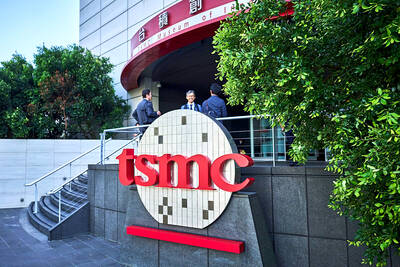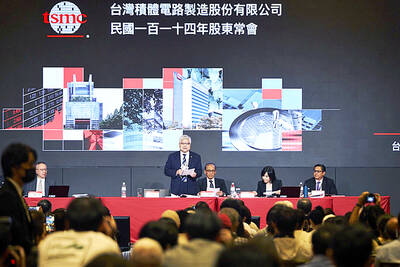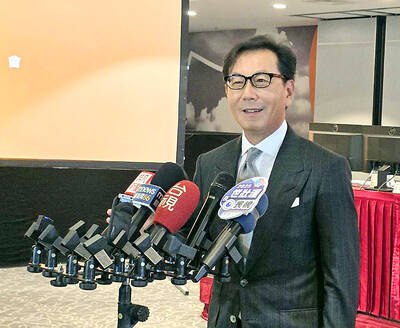Google Inc reported on Thursday that its quarterly profit rose with a jump in revenue and released word that its chief business officer was leaving the company.
High-profile executive Nikesh Aurora took a moment on the earnings call to thank Google for a “phenomenal” 10 years and said he looked forward to “cheering them on from the sideline.”
Arora will be replaced in the interim by Omid Kordestani, a business founder who led Google’s sales teams.
Google chief financial officer Patrick Pichette steered talk on the earnings call away from Aurora’s career move to a job at Japan’s Softbank Corp, saying he wanted to keep focused on freshly released quarterly earnings figures.
The California-based Internet titan said its profit jumped during the three months ending on June 30, rising 6 percent from a year ago to US$3.42 billion.
Revenue was up 22 percent year-on-year, at US$16 billion.
“We are moving forward with great product momentum and are excited to continue providing amazing user experiences, with a view to the long term,” Pichette said.
Google shares rose about 1 percent to US$579 in after-market trading that followed release of the earnings figures.
Google said a key factor in revenue was the jump in “paid clicks,” for ads related to searches on Google and its partner sites.
Total paid clicks were up 25 percent from one year ago and 2 percent from the past quarter, while the average cost per click was down 6 percent from a year earlier.
Google is the leader in digital advertising and had a 31.9 percent share of the global market last year, according to the research firm eMarketer.
The closest rival was Facebook with 5.8 percent.
According to eMarketer, Google has more than 50 percent of the worldwide mobile advertising market.
Google’s profit per share was US$6.08, about US$0.16 below analysts’ forecasts, but revenues were better than the average estimate of US$15.6 billion.
Google makes most of its money from digital advertising. However, it has been diversifying into other areas such as home automation, self-driving cars and wearable technology such as smartwatches and Internet-linked eyewear, with the release of Google Glass in April.
Pichette told analysts that Google takes a venture capitalist approach to new projects, calling on teams to hit milestones and make their cases when it comes to being funded.
With projects such as autonomous cars under way in the Google X lab, payoff could be years away, while new software innovations could generate faster returns.
Pichette told analysts that Google has about 60 percent of its cash reserves outside the US and that there was an “interesting case” for keeping it there.
“We do have great opportunities outside the US to invest our cash,” Pichette said, noting opportunities for acquisitions, building data centers and expanding offices.
He added that Google has “exciting plans” for its capital in the Asia-Pacific and Europe regions.

CAUTIOUS RECOVERY: While the manufacturing sector returned to growth amid the US-China trade truce, firms remain wary as uncertainty clouds the outlook, the CIER said The local manufacturing sector returned to expansion last month, as the official purchasing managers’ index (PMI) rose 2.1 points to 51.0, driven by a temporary easing in US-China trade tensions, the Chung-Hua Institution for Economic Research (CIER, 中華經濟研究院) said yesterday. The PMI gauges the health of the manufacturing industry, with readings above 50 indicating expansion and those below 50 signaling contraction. “Firms are not as pessimistic as they were in April, but they remain far from optimistic,” CIER president Lien Hsien-ming (連賢明) said at a news conference. The full impact of US tariff decisions is unlikely to become clear until later this month

GROWING CONCERN: Some senior Trump administration officials opposed the UAE expansion over fears that another TSMC project could jeopardize its US investment Taiwan Semiconductor Manufacturing Co (TSMC, 台積電) is evaluating building an advanced production facility in the United Arab Emirates (UAE) and has discussed the possibility with officials in US President Donald Trump’s administration, people familiar with the matter said, in a potentially major bet on the Middle East that would only come to fruition with Washington’s approval. The company has had multiple meetings in the past few months with US Special Envoy to the Middle East Steve Witkoff and officials from MGX, an influential investment vehicle overseen by the UAE president’s brother, the people said. The conversations are a continuation of talks that

CHIP DUTIES: TSMC said it voiced its concerns to Washington about tariffs, telling the US commerce department that it wants ‘fair treatment’ to protect its competitiveness Taiwan Semiconductor Manufacturing Co (TSMC, 台積電) yesterday reiterated robust business prospects for this year as strong artificial intelligence (AI) chip demand from Nvidia Corp and other customers would absorb the impacts of US tariffs. “The impact of tariffs would be indirect, as the custom tax is the importers’ responsibility, not the exporters,” TSMC chairman and chief executive officer C.C. Wei (魏哲家) said at the chipmaker’s annual shareholders’ meeting in Hsinchu City. TSMC’s business could be affected if people become reluctant to buy electronics due to inflated prices, Wei said. In addition, the chipmaker has voiced its concern to the US Department of Commerce

STILL LOADED: Last year’s richest person, Quanta Computer Inc chairman Barry Lam, dropped to second place despite an 8 percent increase in his wealth to US$12.6 billion Staff writer, with CNA Daniel Tsai (蔡明忠) and Richard Tsai (蔡明興), the brothers who run Fubon Group (富邦集團), topped the Forbes list of Taiwan’s 50 richest people this year, released on Wednesday in New York. The magazine said that a stronger New Taiwan dollar pushed the combined wealth of Taiwan’s 50 richest people up 13 percent, from US$174 billion to US$197 billion, with 36 of the people on the list seeing their wealth increase. That came as Taiwan’s economy grew 4.6 percent last year, its fastest pace in three years, driven by the strong performance of the semiconductor industry, the magazine said. The Tsai